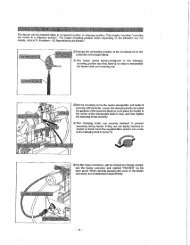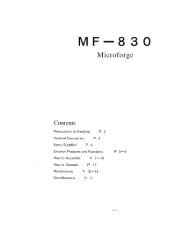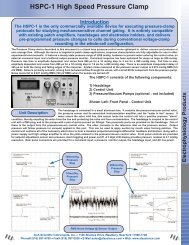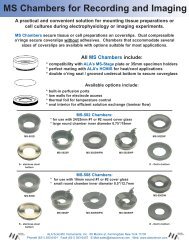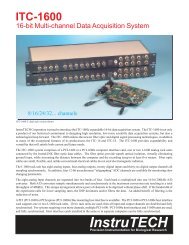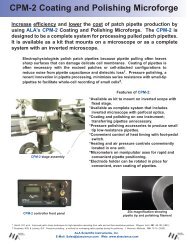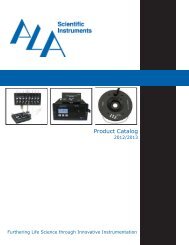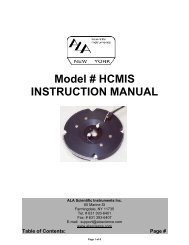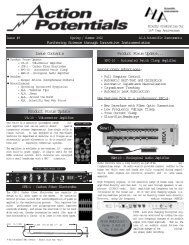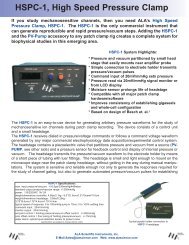™ KCL Bridge Electrode Holder - ALA Scientific Instruments
™ KCL Bridge Electrode Holder - ALA Scientific Instruments
™ KCL Bridge Electrode Holder - ALA Scientific Instruments
Create successful ePaper yourself
Turn your PDF publications into a flip-book with our unique Google optimized e-Paper software.
<strong>KCL</strong> <strong>Bridge</strong> <strong>Electrode</strong> <strong>Holder</strong><br />
Easy-to-use electrode holder for microelectrodes to stabilize electrode<br />
potentials and eliminate CI- from recording solution.....<br />
Electrophysiological techniques require stable electrode potentials for accurate readings. For stability,<br />
electrodes must be reversible and mechanically isolated from stress, strain, and non-equilibrium chemical exposure.<br />
Ag/AgCl electrodes are the most common reversible electrodes used for patch clamp & intracellular<br />
recording pipettes. These are readily prepared from silver wire or sintered Ag/AgCl pellets. In pipettes the wire<br />
is easiest to use since it can be simply inserted into the back of a saline filled pipette. Because of their larger<br />
surface area, the sintered pellets are more stable, but may accumulate bubbles at the fluid pellet interface.<br />
For AgCl electrodes to be reversible, the filling solution must have mobile Cl- ions. This is not always possible,<br />
particularly in biophysical experiments where pipettes may contain a wide range of anions other than Cl- such<br />
as F-, gluconate, etc. Under these conditions, the AgCl pellet forms a non-reversible electrode interface whose<br />
potential drifts with time and usually requires large offset potentials from the amplifier to back standing currents.<br />
Similar problems may occur from simply scratching the Cl- coating on a silver wire by inserting it into the<br />
unpolished pipette. This leaves a metallic Ag and an AgCl interface in contact with the filling solution creating<br />
an unstable battery. We have designed a simple electrode holder that minimizes these problems. 1<br />
<strong>KCL</strong> <strong>Bridge</strong>:<br />
♦ Eliminates need for Cl containing solutions in recording pipettes<br />
♦ Provides stable offset potential<br />
♦ Improves noise performance<br />
♦ Easy set-up and disassembly<br />
♦ Available for all glass sizes<br />
♦ Connections for all amplifiers<br />
♦ Completes circuit from AgCl pellet to recording electrode via quartz capillary<br />
Axon Universal Headstages<br />
BNC type headstages<br />
PPH-<strong>KCL</strong>-AU<br />
PPH-<strong>KCL</strong>-B<br />
The basic idea is to replace the AgCl wire with a fluid filled quartz capillary tube. The tube is connected to a KCl<br />
filled reservoir containing a Ag/AgCl pellet. Polyamide coated quartz tubes developed for HPLC are extremely<br />
sturdy, flexible, inert, and often used as filling needles for pipettes. They can be repeatedly inserted into pipettes<br />
without damage. The KCl fluid path through the capillary provides a liquid junction interface with minimal offset<br />
potentials, particularly when the KCl concentration is much higher than the pipette solution. This is because the<br />
K+ and Cl- mobilities are similar and dominate the diffusion potential when the concentration is much higher<br />
than the pipette solution. 2<br />
Typical liquid junction potentials would be below 15 mV, even for uncommon ionic<br />
compositions.<br />
One can insert the tip of the capillary into a pipette filled with, for instance, KF solution, and expect stable offset<br />
potentials. The capillary has the additional advantage of low capacitance that reduces the noise produced<br />
by the voltage noise of the patch input stage. The capillary tubing is available in 200µm and 100µm interior<br />
diameter, a much smaller diameter than the 0.25mm typical diameter of most silver wires. Since the capacitance<br />
of a wire is proportional to the logarithm of the diameter, small wires have lower capacitance than large wires.<br />
Smaller wires produce lower amplifier noise in the high frequency range. 3<br />
However, it should be noted that this<br />
advantage is only attained when the pipettes themselves are minimally filled.<br />
<strong>ALA</strong> <strong>Scientific</strong> <strong>Instruments</strong>, Inc. • 1100 Shames Drive, Westbury, New York 11590-1746<br />
Phone# (516) 997-5780 • Fax# (516) 997-0528 • E-Mail:sales@alascience.com • Web: www.alascience.com
<strong>KCL</strong> <strong>Bridge</strong> <strong>Electrode</strong> <strong>Holder</strong><br />
Offset potentials measured using the<br />
<strong>KCL</strong> <strong>Bridge</strong> holders (A) and conventional<br />
holder (B) w/AgCl wire.<br />
Note the different “Y” axis values.<br />
PPH-<strong>KCL</strong>-AXC<br />
PPH-<strong>KCL</strong>-AXP<br />
PPH-<strong>KCL</strong>-AU<br />
PPH-<strong>KCL</strong>-BNC<br />
Ordering Details and Accessories<br />
<strong>KCL</strong> bridge pipette holder for Axon Axoclamp 2A Type Headstage<br />
<strong>KCL</strong> bridge pipette holder for Axon 1D/200A Type Headstage<br />
<strong>KCL</strong> bridge pipette holder for Axon Universal Type Headstages<br />
<strong>KCL</strong> bridge pipette holder for BNC Type Headstages<br />
References<br />
1) Snyder, Kriegstein, & Sachs, A<br />
convenient electrode holder for glass<br />
pipettes to stabilize electrode<br />
potentials, Pflugers Arch. 438: 405-411<br />
(1999).<br />
2) Benndorf 1995 Low-noise recording.<br />
In Single Ch. Recording pp. 129-146.<br />
3) Bockris & Reddy 1970, Modern<br />
Electrochemistry, Plenum Press, NY.<br />
is a trademark of <strong>ALA</strong> <strong>Scientific</strong> <strong>Instruments</strong>, Inc.<br />
<strong>ALA</strong> <strong>Scientific</strong> <strong>Instruments</strong>, Inc....“Furthering Science through Innovative Instrumentation”



